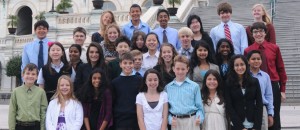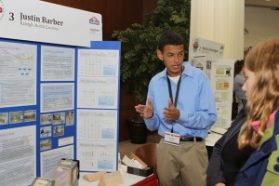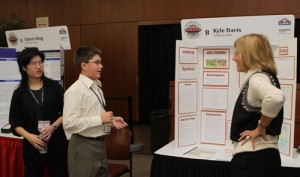Young scientists come to Washington
Thirty middle school students compete in the inaugural Broadcom MASTERS science challenge

On a chilly, rainy October morning in Washington, D.C., two middle school students from Hawaii sat shivering on a tour bus as they waited to depart for a photo shoot at the U.S. Capitol.
“I don’t know how people live here,” said Jordan Kamimura, 14, of Hilo, Hawaii, through chattering teeth.
But the temperatures proved no deterrent for the participation by these and 28 other finalists in the inaugural Broadcom Math, Applied Science, Technology and Engineering for Rising Stars — or MASTERS — competition. The three-day contest tapped some of the nation’s top middle school science students to present posters exhibiting their individual research projects at a science fair. Then the students divided into teams to solve a series of challenges in science, technology, engineering and math.
A panel of researchers had selected the 30 competitors from among nearly 1,500 applicants across the United States and Puerto Rico. The students had been nominated to apply to this MASTERS competition after taking part in a local, regional or state science fair affiliated with Society for Science & the Public, which also publishes Science News for Kids.
With their posters on display in a meeting room at the National Geographic Society, students began the competition by fielding questions from judges. Each student was asked to explain things ranging from the role of primers in DNA amplification to predicting how the student would improve his or her project if given a million-dollar research grant.
The judging, most students agreed, was a level above what they had experienced at their home fairs.
Kyle Davis, 14, of Sunbury, Ohio, spoke with one judge about his project correlating the size of song sparrows with their geographic ranges. As the judge interviewed him, Davis addressed a series of thought-provoking questions: Why might the size of a bird have anything to do with air temperature? How might geometry relate to this relationship? What about surface area?
“He asked me questions that the judges at other science fairs never asked,” Davis says. “It was cool to know what he was talking about, but these questions took a little more thinking. It got to that level of being like coaching.”

Justin Barber, 14, of Raleigh, N.C., agrees. After speaking with the judges, he says he now looks at his project — to determine the optimal roof design for homes in tornado-prone areas — in a new light.
“I had lots of surprises as I went along in this experiment,” Barber says. Until the judge brought it up, “I never thought about how drag would affect the effect of wind on different roof shapes.”
Carolyn Jons, 13, of Eden Prairie, Minn., had a similar experience. As she described her work experimenting with the insulating capabilities of soap bubbles, she was surprised by the nature of the judges’ questions. They were more complicated and required far more contemplation to answer, she said. “One judge asked a lot of math questions, like how to measure the radius of a bubble without popping it. And that was a new question for me.”
The five judges — who previously had selected these students from the pool of applicants — emphasized the importance of originality and innovation in the projects they selected as winners. Projects that followed a “cookbook” procedure or that modeled closely the ideas found on science fair websites were quickly rejected.
“I don’t want to see another entry showing how planaria go back and forth from light to dark, or regrow in different media,” quips judge Susan Baker, a fisheries biologist with the National Oceanic and Atmospheric Administration.
“Projects don’t need to be the most sophisticated or complicated. I’d rather see something that is elegant, done cleanly, with data to back it up,” she says.
Baker also hinted at how judges determined whether students — and not their parents or other mentors — did the work on fair projects. “If you can explain dark matter to me, a topic about which I know absolutely nothing, that tells me that you understand it and you did the work,” she says.
Another characteristic winning projects had in common: All, in some way, reflect a student’s genuine interest and curiosity about a question that can be approached scientifically. “I look at science fairs as a form of self-expression,” says Paula Golden, executive director of the Broadcom Foundation, which cosponsored the competition. “A kid can do a science fair project on anything.”
A quick survey of the qualifying projects proves that point, and makes another: Good science fair projects often stem from personal experiences.
Crystal Poole, 14, of San Diego, for instance, grew up decorating cakes. “My grandmother is a professional cake decorator, so I’ve heard plenty of stories about wedding cakes with frosting that doesn’t stand up to the heat outside,” she explains. For Poole’s science fair project, she experimented with different food additives to see which gave buttercream frosting the most heat resistance. She went on to win the competition’s mathematics award for her project — and for her performance in math-related team challenges.
Other students were inspired by their families’ healthcare experiences.
Namarata Balasingam, 13, of San Jose, Calif., had two grandparents go through angioplasty, a surgery in which a small balloon is placed inside a blood vessel. Intrigued by this procedure, Balasingam set out to determine how variables such as vessel radius and wall thickness affect the pressure inside of balloons.
The grandmother of Benjamin Hylak, 14, of West Grove, Pa., resides in an assisted living center. Hylak designed and built an interactive robot to connect her fellow residents with family and friends. For his robot-building skills and ability to work as part of a team, he took second place in the Broadcom MASTERS competition.
Still other students funneled their basic curiosity about a topic into projects that allowed them to learn about fields of science they had not yet encountered in the classroom.

Valerie Ding, 14, of Portland, Ore., for example, first heard of quantum physics in seventh grade. She wanted to learn more about the field. So she developed a computer model that uses quantum theory to predict how different materials would behave in LEDs, or light-emitting diodes.
“There’s a specific adrenaline rush when you’re learning something new,” Ding says. “It’s so cool learning about a new field and having this opportunity to follow the passion you have.”
Coleman Kendrick, 13, of Los Alamos, N.M, grew up looking through telescopes with his father, a theoretical physicist. Kendrick first learned about dark matter when he was in the fourth grade. To learn more about it, he used computer models to approximate dark matter’s effects on galaxy rotation.
His computer models didn’t provide the results he had expected, but that didn’t bother him. “I like the unexpected,” he says. “It gives you a new view of things you might not have thought of before.”
While these individual science fair projects are what qualified students for Broadcom MASTERS, their performance in a series of group challenges during their stay in Washington largely determined an individual’s final overall score.
Over two grueling days, students worked in teams of five on a number of group challenges. Together, they tackled everything from purifying a sample of contaminated water and identifying unknown indicator solutions to creating a deliberately complex machine that could pour a serving of dog food into a bowl.
Each challenge required students to think on their feet, apply their knowledge in math and science to new situations and work with others on a common goal.
“We’re not looking for, did you get it right,” said judge Bill Wallace, a science teacher at Georgetown Day School in Washington, D.C., and former biologist at the National Institutes of Health. “There are many ways to solve these challenges. What we’re looking for is how you got there, how you use creativity, how you communicate and how you work together,” he told the students on the first day of group challenges
Creativity, the students quickly figured out, was in high demand. “It’s the only way of getting anything done when there’s no defined procedure,” says I-Chun Lin, 14, of Plano, Texas. Lin placed third overall in the competition after initially qualifying with her project that tested solar cells made from fruit pigments.
In even higher demand than creativity was the ability to collaborate. At the end of the competition, 10 awards were handed out, based not only on the students’ individual science fair projects but, more importantly, on the teamwork and leadership students exhibited throughout the group challenges. Significantly, one award went not to an individual, but to the team that performed most effectively as a group.
“The poster competition let us see who the students are,” Golden says. After that, she says, “The slate is wiped clean,” and the young scientists enter the team projects from a level playing field. Based on how they go on to perform in the on-site challenges, she explains, “We can see who each student can be.”
The Broadcom MASTERS competition is cosponsored by Society for Science & the Public, publisher of Science News for Kids.